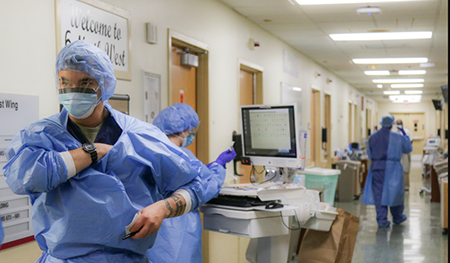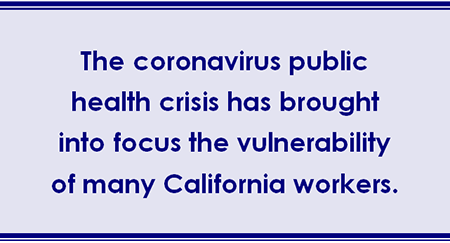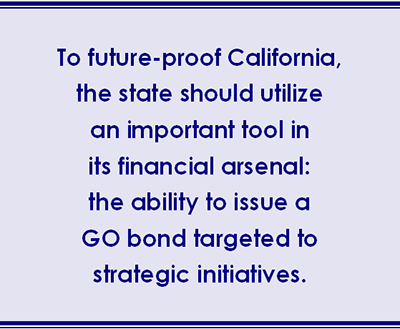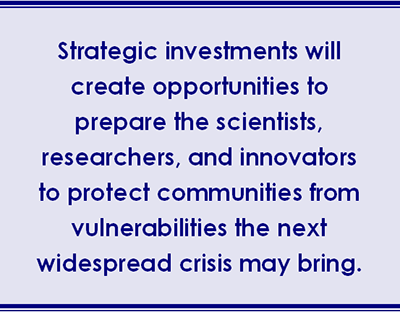You can also view this newsletter as a PDF.

Future-Proofing California:
A Call for Bold, Strategic Public Investment
To combat the devastating impacts of the novel coronavirus (COVID-19), governments have been rightly focused on solving the health crisis and saving lives. However, the lasting issue of saving livelihoods also must be addressed. Shuttering large parts of our economy has resulted in rapid and growing income loss to millions of Californians. The COVID-19 pandemic has laid bare that our old “booming” economy did not work for everyone. With the Band-Aid now ripped off, we have a unique opportunity to address decades of neglect to strengthen our economy with public investments that not only secure our survival but ensure equity and shared prosperity.
The current economic hardships are dire. The number of California unemployment claims now exceeds the number of jobs the state created during the recovery from the Great Recession. Another wave of layoffs likely will occur as many small and medium-sized businesses are unable to secure financial relief.
Even before the pandemic, rising inequality left workers to fend for themselves with stagnant wage growth, despite decades-long productivity gains. One-third of California’s workers — many with college degrees — make $15 per hour or less. California has the highest rate of poverty when accounting for the cost of living, and too many workers are left without critical protections and safety net services.
California has a significant role to play in future-proofing our economy and generating good-paying jobs and sustainable work, rather than returning to the vulnerable economy of 2019 whose foundation rested on the less-than-robust financial health of workers.
Future-proofing has long been an industrial design concept, applied to minimize the shocks and stresses of anticipated events including recent application to climate change. However, the economic shocks and stresses of the COVID-19 pandemic are vast, and every day reveals new lessons for how California must better prepare to tackle known and unforeseeable challenges ahead. This will require risk-intelligent leadership, long-term planning as well as short-term actions, dedication to reducing vulnerability and building resiliency, and creativity in how we utilize our physical, financial, and human resources — executed with discipline and informed by science and data.
Building the Economy of the Future:
Protecting Our Human and Natural Capital
Staying Prepared and Ready With Systems-Hardening. The COVID-19 pandemic caught many jurisdictions around the world ill-prepared, including California. On the heels of the worst wildfire years in state history that claimed lives and ravaged communities, the coronavirus crisis is wreaking havoc on the state’s economy, local governments, and the lives of many Californians, especially those in communities of color, low-income areas, and rural regions. As anticipation builds for loosening orders and re-opening the economy, anxiety is growing. Many want to return to pre-COVID-19 economic activity. Others recognize pre-COVID-19 jobs likely will be gone.
 Future-proofing California’s economy must include the hardening of our public health infrastructure: preparing a more expansive workforce, improving information systems, and upgrading laboratories. The coronavirus pandemic is challenging the ability of our public health infrastructure to control an infectious disease. Yet a strong, effective public health infrastructure also is critical for chronic illness prevention and monitoring, clean air and safe water monitoring, food safety inspections, and disaster prevention and response. Public health must expand its capacity and capabilities, and such expansions can be effective especially in economically distressed communities.
Future-proofing California’s economy must include the hardening of our public health infrastructure: preparing a more expansive workforce, improving information systems, and upgrading laboratories. The coronavirus pandemic is challenging the ability of our public health infrastructure to control an infectious disease. Yet a strong, effective public health infrastructure also is critical for chronic illness prevention and monitoring, clean air and safe water monitoring, food safety inspections, and disaster prevention and response. Public health must expand its capacity and capabilities, and such expansions can be effective especially in economically distressed communities.
The experiences offered by wildfire devastation since 2017 have heightened attention about the need to harden fire prevention and suppression capabilities as well, to take on the “new normal” of weather-creating wildfires and other climate-related events.
California has 33 million acres of forestlands, much of them devastated by droughts and wildfires in recent years. Investing in forest management can help protect the 11 million Californians living in harm’s way, improve air quality, and advance carbon sequestration and other climate benefits — saving human lives and reducing costs for emergency services and disaster recovery. California Forward’s recent Call to Action estimated a minimum investment of $1 billion annually for 10 years. This investment must include fuel reduction, forest thinning, and support for new woody biomass industries. Bold, strategic investments to build workforce and community capacity, especially in the Sierra Nevada region with high levels of poverty and low educational outcomes, will strengthen local economies by attracting new industries and creating forest management-related jobs.
Addressing the Climate Crisis with Natural and Working Lands. Climate change and its impacts are having significant detrimental effects on California’s natural and working lands. Supporting a $54 billion industry comprising 76,400 farms and ranchers with global reach, our agricultural lands — through conservation practices — deliver 35 percent of the available land habitat for migratory birds.
Continuation of current trends could lead to development of 1.3 million acres by 2050, threatening the wildlife habitat that agricultural lands provide. Heat waves will increase in the 21st century. Droughts will increase in frequency and intensity. Reduced crop and livestock productivity will disrupt food supplies and food chains. This volatility requires better integration of land and water use, creating further pressures on communities.
Investing in natural and working lands is an important strategy for avoiding the impacts of climate change. We must embrace nature-based solutions by protecting, restoring, and sustainably managing our forests, grasslands, wetlands, and other critical lands. These changes — including integrated programs for water efficiency, digesters to produce energy, and improvements in the operations of the lands — will result in sustainable, healthier food and better quality of life in agricultural communities. Additionally, there are opportunities for regional food supply chains to thrive throughout the state, as local production and distribution bolster security.
California’s coastal communities already are seeing the effects of sea-level rise. State funding should support Regional Coastal Adaption Plans, with grants awarded for construction of coastal adaptation projects to test new approaches. To protect communities and commerce, it is critical to invest in natural solutions and hard structures, informed by pilot projects across the state that demonstrate the efficacy of various strategies. Science, research, and data should guide funding decisions. Additionally, as more demands are placed on public lands, funding must be sustained to improve them, such as programs for hazard removal, oil platform decommissioning, and removal of abandoned vessels from waterways.
The Future of Our Workforce: Focus on Workers. The coronavirus public health crisis has brought into focus the vulnerability of many California workers. Employers’ responses to the plight of their employees have been mixed on an array of issues such as the timing of furloughs and layoffs, provision of personal protective equipment, and application of sick leave policies.
 In 2019, Governor Gavin Newsom convened the Future of Work Commission, with the charge of developing a new social compact for California workers based on an expansive vision of economic equity with work and jobs as a starting point. The Commission has given attention to the concept of high-road employment, where workers have agency and voice with respect to job quality. As California looks to protect its human capital while rebuilding the economy, labor unions, employers, and government must work together to make high-road employment possible across all sectors. Federal or state stimulus funds may be leveraged as workforce investments to encourage businesses to pay fair wages and benefits, comply with federal and state labor laws, and provide training, education, and advancement opportunities.
In 2019, Governor Gavin Newsom convened the Future of Work Commission, with the charge of developing a new social compact for California workers based on an expansive vision of economic equity with work and jobs as a starting point. The Commission has given attention to the concept of high-road employment, where workers have agency and voice with respect to job quality. As California looks to protect its human capital while rebuilding the economy, labor unions, employers, and government must work together to make high-road employment possible across all sectors. Federal or state stimulus funds may be leveraged as workforce investments to encourage businesses to pay fair wages and benefits, comply with federal and state labor laws, and provide training, education, and advancement opportunities.
Coronavirus response efforts can provide opportunities to put Californians back to work. For example, COVID-19-affected communities can be hired to do contact tracing with rapid training. Additionally, the state can form a valuable partnership with private-sector companies to promote paid retraining by subsidizing wages for workers training on the job. Prolonged unemployment harms workers’ job prospects and their lifetime earnings. Workers without college degrees and workers of color are the most vulnerable to these adverse effects. Creating incentives for employers to hire and train workers in growth industries will yield benefits for all.
For example, workforce development programs may bolster the solar power industry and invest in on-the-job training incentives. Work developing solar panels and battery storage systems — especially in rural areas and public buildings — can offset the 15 percent of jobs lost in the energy efficiency and renewable energy sectors while continuing to reduce reliance on the electric grid and build on California’s progress in reaching ambitious climate goals.
 Meeting the Connectivity Challenge. The COVID-19 stay-at-home orders have brought broadband infrastructure to the forefront. Accessible, universal, affordable, and reliable high-speed internet is critical for educational instruction at home, remote work, telehealth, e-mental health, business transactions, and social connection. This demand will be sustained such that short-term solutions may deprive communities in the future of educational and economic opportunities, social connection, health information, and overall public safety with poor communications during disasters and emergencies.
Meeting the Connectivity Challenge. The COVID-19 stay-at-home orders have brought broadband infrastructure to the forefront. Accessible, universal, affordable, and reliable high-speed internet is critical for educational instruction at home, remote work, telehealth, e-mental health, business transactions, and social connection. This demand will be sustained such that short-term solutions may deprive communities in the future of educational and economic opportunities, social connection, health information, and overall public safety with poor communications during disasters and emergencies.
Housing as Economic Security. Housing remains a leading economic security issue facing Californians. Investments in housing development are needed for the state to confront its growing housing affordability crisis. Sustained housing investment with predictable funding availability should be coupled with an efficient system (including streamlined environmental review) for allocating state funds to worthy projects across fund sources, a system that maximizes public value versus cost.
More flexible funding mechanisms must be developed for the evolving COVID-19 pandemic, allowing for project operating subsidies and tenant rental assistance vouchers, in addition to traditional development capital funding. Housing development should be located near job centers. Infrastructure needs, including broadband and greener energy, should be incentivized as part of the housing funding.
New options for housing development — including motels, hotels, and office buildings — should be prioritized to redevelop neglected property and prevent sprawl. Existing state priorities for housing development must be reexamined as new patterns of transportation, housing, and work become evident. Fund awards should uphold human capital principles that align with future-proofing initiatives.
Reaching into California’s Financial Arsenal
 To future-proof California, we must envision an economy that is sustainable and resilient; that creates good-paying jobs by investing in strategic projects, housing, and infrastructure informed by sound science, research, and data; and that addresses the adverse effects of climate change. The State of California should utilize an important tool in its financial arsenal: the ability to issue a general obligation (GO) bond in a substantial amount, with proceeds targeted to strategic initiatives in a disciplined manner.
To future-proof California, we must envision an economy that is sustainable and resilient; that creates good-paying jobs by investing in strategic projects, housing, and infrastructure informed by sound science, research, and data; and that addresses the adverse effects of climate change. The State of California should utilize an important tool in its financial arsenal: the ability to issue a general obligation (GO) bond in a substantial amount, with proceeds targeted to strategic initiatives in a disciplined manner.
While the current pandemic will have a substantial negative impact on state finances, California has made great strides over the past several years to put its fiscal house in order. For example, the state has paid off significant amounts of debt and created substantial reserves. These prudent actions earned a credit rating increase by both Moody’s and Fitch. According to the State Treasurer’s Office, California currently has $71.3 billion in outstanding GO debt and an additional $33.6 billion in bonds authorized but not yet issued.
California traditionally has carried more debt than other states. However, the governor’s Department of Finance reports California has substantially improved on two important metrics generally used to evaluate debt: percent of personal income, which went from 5.8 percent in 2013 to 3.7 percent in 2019; and debt per capita, which decreased from $2,565 in 2013 to $2,194 in 2019.
State budget expenditures alone will not provide the magnitude of resources needed to address the effects of the current public health crisis, related economic downturn, and continuing climate crisis. State revenues will face a steep decline in light of the slowdown across nearly all sectors of the economy, and state reserves will be significantly drawn-down or completely expended to cover a surge in short-term state spending. In the near term, requests for state expenditures will increase as government responds to the human toll of the pandemic, especially in areas of public health, public safety, education, and intergovernmental assistance.
California can use a GO bond to inject far more money into the economy in the short term than could reasonably be accomplished in annual budget appropriations. Although there will be a need to earmark part of the budget each year to pay debt service, a bond is a prudent long-term investment to focus and strengthen the recovery, directing funding to strategic future-proofing initiatives that will generate good-paying and sustainable jobs. If the state only is willing to invest what a budget will allow in real cash right now, it will take much longer to recover. Further, this piecemeal approach likely would recreate the economy of 2019, rather than achieve a bold new vision.
The Federal Government Must Do More. The federal government is by no means off the hook from providing additional federal fiscal relief as economic conditions demand. In its latest update, the Congressional Budget Office projects even bigger state budget shortfalls than previously expected. States’ recoveries will be protracted if they are compelled to address these shortfalls with deep cuts to education, health care, local governments, and other areas. These cuts could adversely affect workers, families, and communities; deepen the recession and delay recovery; and jeopardize coronavirus response activities. Sustained federal relief efforts are critical until economic conditions improve and give states breathing room to contemplate their own recovery strategies.
Additionally, fiscal relief and other federal relief legislation must be conditioned to incorporate future risks, informed by the COVID-19 pandemic. For example, relief for large businesses must deliver value to workers and communities, and liquidity facilities must not be wasted by failing to address the risks posed by climate change. The federal government must be a partner with states for future-proofing our economies now; it cannot wait to act on climate and the declining financial health of so many Americans.
Moreover, California need not shoulder the full costs of a GO bond. Build America Bonds (BABs) were authorized in the American Recovery and Reinvestment Act of 2009 to spur public infrastructure projects and stimulate the economy following the 2008 recession. Under this program, the federal government paid 35 percent of interest due on taxable bonds sold by state and local governments for capital projects. These bonds became very popular with investors and helped many issuers retain their access to capital markets and generate stimulus funds for jobs and infrastructure.
From April 2009 through December 2010, more than $181 billion of BABs were sold in 2,275 separate financings. A May 2011 report by the U.S. Department of the Treasury estimated BABs saved issuers an average 84 basis points of interest as compared to traditional tax-exempt bonds. This equates to an estimated $20 billion savings in interest costs. Over the course of the program, California (including the state, local governments, and school districts) issued $37.7 billion of BABs in 158 financings. This was the largest amount of BABs sold in the country, followed by New York with $20.6 billion and Texas at $16.7 billion. The Brookings Institution published a 2013 paper calling for the relaunch of the program, noting it was more efficient than tax-exempt bonds.
 The Need for Place-based Investments. For too long, low-income communities, remote communities, and communities of color have seen little deployment of capital to address their needs. The strategic targeting of GO bond proceeds can be the catalyst for attracting much needed capital to marginalized areas. The historic neglect of these communities has resulted in losses with respect to social, economic, and environmental returns. If we aspire to equity and shared prosperity, reversing this spiral of disinvestment must be a priority.
The Need for Place-based Investments. For too long, low-income communities, remote communities, and communities of color have seen little deployment of capital to address their needs. The strategic targeting of GO bond proceeds can be the catalyst for attracting much needed capital to marginalized areas. The historic neglect of these communities has resulted in losses with respect to social, economic, and environmental returns. If we aspire to equity and shared prosperity, reversing this spiral of disinvestment must be a priority.
These investments may spur community partnerships to establish a public health infrastructure footprint, manufacturing jobs for medical supplies and equipment, new entrepreneurship opportunities for disseminating climate technology, innovative community-based solutions to address food deserts, and more. Most importantly, they will create opportunity to educate, train, and prepare the scientists, researchers, architects, builders, and innovators to protect communities from vulnerabilities the next widespread crisis may bring.
Public Investment to Build Public Trust
Asking a majority of California voters to subscribe to a vision to future-proof the state and approve a GO bond to rebuild the economy is asking them to believe in California — not just the California they know, but the California that could be. It is a California that leverages our assets — the knowledge, science, research, innovations, and technology of higher education institutions, community colleges, K-12 public schools, private sector partners, and workers across all sectors — to inform investments in communities most affected by the COVID-19 crisis, as well as those not well-served by the economy of the past. It is a California where worker voices can be amplified to inform the future of work, harnessing the abundant talent that makes reimagining work possible to future-proof our economy.
 We owe Californians the opportunity to invest in a state that is strong enough to meet the challenges of the future. If plans are executed with transparent, swift, and decisive action informed by sound science, California will be on the path to building resilience in communities up and down the state as well as building trust — inspired by the lessons of this pandemic — that each of us is essential to the other.
We owe Californians the opportunity to invest in a state that is strong enough to meet the challenges of the future. If plans are executed with transparent, swift, and decisive action informed by sound science, California will be on the path to building resilience in communities up and down the state as well as building trust — inspired by the lessons of this pandemic — that each of us is essential to the other.